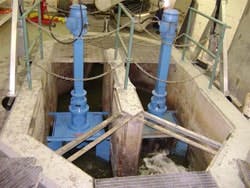The district of Kitimat, B.C, a coastal community with 10,000 residents, is located at the head of the Douglas Channel and the Kitimat River. The area is a major salmon-spawning corridor, supporting a large sports fishing industry. For both ecological and economic reasons, any facility discharging wastewater into the river must be mindful of strict discharge regulations. No one is more aware of this than the management of the Kitimat Wastewater Treatment Plant.
Recently, the plant, which treats 2.6 million gal per day (mgd) and handles peak flows of 7.3 mgd, underwent an emergency upgrade. A barminutor, installed in the 1970s as a bar screen and grinder, had rusted and developed holes, allowing rags, wood, rocks and other debris to pass through. The debris caused blockages and clogs in the aerators and also contributed to a sludge buildup in the lagoon. Management at the facility was determined to install a more efficient system and end the chronic problems. After carefully reviewing their options, they chose Franklin Miller’s Dimminutor Turbo Design Channel Disintegrator .
The comminutors were placed side by side in two existing channels. “With the supplied frames they were easily installed into the existing headworks units,” Sussbauer said. “This was a consideration in the purchase.”
In Kitimat, effluent flows by gravity to a wet well and is then pumped by three screw pumps into the headworks, where the two comminutors are located. All the wastewater solids are finely ground before entering an aerated lagoon. The treated effluent is then discharged into the river. Installation of the units has made a noticeable difference. “They play a key role in protecting the aerators from clogging, reducing the need for maintenance and enhancing the treatment process,” Sussbauer said.
The Dimminutor offers effective automatic screening and disintegrating of wastewater solids in straight-through channels and wet wells. This powerful unit reduces plastics, wood, rags and other solids to fine bits, improving the reliability of pumps and other downstream equipment.
The unit employs a smooth, continuously rotating design with high torque. As its three bidirectional rotary cutters intermesh at close clearance with stationary cutters, solids are reduced to a size small enough to pass through a sizing screen. With no gaps or openings between the screen and cutters, output is controlled and complete reduction assured.
The unit has an intrinsically open design to handle high flow rates with low head loss. This unit features individually replaceable cutters, oil lubrication and a simple rotary design requiring no auxiliary diverter screens. A cantilevered design eliminates seals or bearings near the gritty channel floor, and every component of the unit is constructed for precision and long life.
